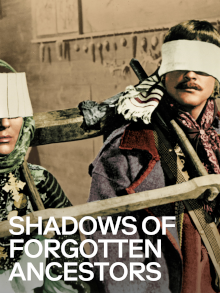I’d bet many people including myself added this to their list of films to watch after the events of last year. This is considered one of the most highly acclaimed Ukrainian films of all time and was made during the USSR era. In many ways this feels more like a documentary than a film as its plot is barebones and very straightforward. The real delight is in how vividly it captures village life in the Carpathian Mountains that is its setting, complete with their costumes, music, dances, customs and more. I also found it notable how dark it is as a story of a typical man’s life which I’d attribute to the character of the Russian psyche.
In a small village in the Carpathians, a feud that begins in church ends with one man killing another with an axe. The widow curses the other family yet her son, Ivan, grows up with their daughter, Marichka, as his playmate. They become inseparable and when they grow up profess their love for one another. Ivan goes to a neighboring village to work as a laborer to earn money to marry Marichka. While he is gone however, Marichka falls into a river and drowns. Ivan is grief-stricken and loses all will to live for a time as even his mother dies. Eventually while shoeing a horse for a more prosperous household, he meets another woman Palahna who seems to take a liking to her. They marry and hold a traditional marriage ceremony. Yet afterwards though Ivan is diligent at working on the farm, he is unable to forget Marichka and his marriage with Palahna is a joyless one.
I’ve read claims of this being a sort of Ukrainian Romeo and Juliet but that isn’t the case at all. The feud between the two families is mentioned but doesn’t really play a part in the story and everyone in the village expects Ivan and Marichka to be together. Thematically, the film is more about the precariousness of life in the Carpathians. Ivan’s mother laments his other siblings who have died, presumably in infancy or early childhood. Then of course Marichka’s sudden death is a shock and Ivan’s own eventual demise completes the circle. We see also how central Christianity is in their lives and in their speech while belief in the supernatural remains prevalent. It really is quite remarkable that this was made at the height of the USSR given its gloomy depiction of life, the importance of religion and its proud assertion of Ukrainian identity.
The film makes use of some interesting, avant-garde techniques. It switches between black-and-white and color to reflect the changes in Ivan’s life and mood, the camera whirls madly around to capture their dances and ceremonies. There are some shots, discolorations and odd angles that feel like technical mistakes, but in the end becomes part of the charm of Soviet filmmaking. The depiction of their customs, such as how the couple are literally yoked together as part of the marriage ceremony, and some of the daily routines of their village are all fascinating. Still without these elements being incorporated as part of a more dramatic story, it’s hard for us to feel very attached to what is in effect a documentary-style presentation.
All in all, it’s easy to see why this film is a Ukrainian national treasure and I’d say it’s worth watching even for non-Ukrainians. Much of its richness is inaccessible to us, not being able to understand the Ukrainian language and not being able to differentiate between Ukrainian culture and Russian culture. But there’s still enough of interest in it to us and it is gratifying to watch this to learn more about them as a people.
